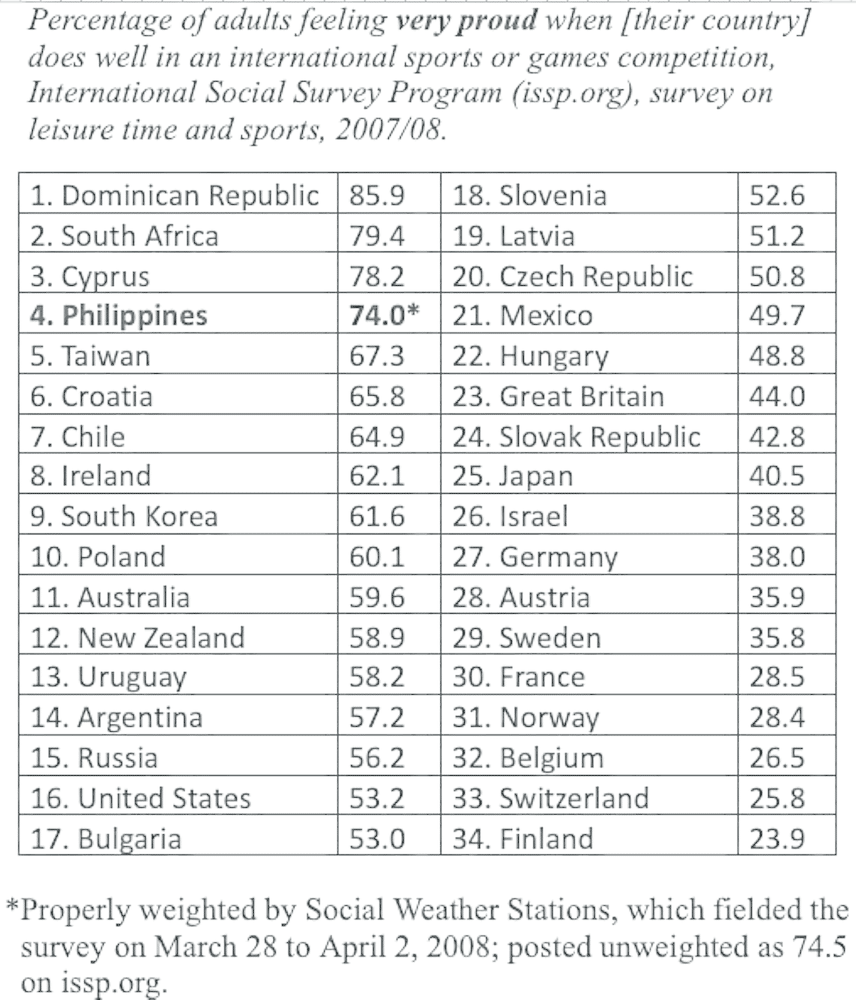Pride from international sports
The International Social Survey Program (issp.org)—in which Social Weather Stations (SWS) has been the Philippine member since 1990—provides the best-quality global evidence on sources of national pride.
For us Filipinos, the top three sources of national pride happen to be our sports achievements, our history, and our arts and literature (“Ten aspects of national pride,” 6/14/14). Other sources of national pride tested were: scientific achievements, the quality of the armed forces, how democracy works, political influence in the world, the system of social security, and the fair treatment of all groups. That’s as of 2013; there was a replication in 2023, which will be published in due time.
As for performance in international sports competitions in particular, there is a more specific ISSP question: “How proud are you when the Philippines does well in an international sports or games competition?” (Gaano ninyo ipinagmamalaki ang Pilipinas tuwing nagwawagi sa pang-internasyonal na isport o laro?) For this, the answer-choices are: “Very proud, Somewhat proud, Not very proud, and Not proud at all.” (Talagang ipinagmamalaki, Medyo ipinamamalaki, Hindi masyadong ipinagmamalaki, Talagang hindi ipinagmamalaki.)
This question was last used in 2007/08, in 34 ISSP countries, with the proportions feeling Very Proud in the table on the right. I wrote about it during the 2019 Southeast Asian Games, hosted by the Philippines (“Sports and national pride,” 12/7/19).
Filipinos are fourth among 34 ISSP countries feeling Very Proud about doing well in international sports. Note that the tiny countries Dominican Republic and Cyprus are No. 1 and No. 3. South Africa is No. 2. Right after Filipinos are the Taiwanese. Whereas Finland, the perennial “happiest country,” ranks No. 34. Nos. 27 to 34 are all European countries. “Pride,” “happiness,” and economic status are not closely related.
For a simple majority to be very proud is common—the median is 53 percent. Those very proud are the majority in 20 of the 34 countries. But for over 70 percent to be very proud is rare—only four out of 34 countries are in this range. China is not in the table because it was not an ISSP member yet. To be a member requires commitment to conduct the common annual survey and to attend the annual meeting, at one’s own expense. The survey topic and the questionnaire drafting group members are decided by majority vote, on a one-country, one-vote basis; so is each survey question. Failure to conduct the survey for two consecutive years results in suspension of voting rights. (Incidentally, SWS has never missed conducting the annual ISSP survey.)
Other Philippine survey numbers, as of 2008. Aside from the 74.0 percent very proud, the other Philippine proportions were: Somewhat proud, 18.6; Not very proud, 4.8; Not proud at all, 1.7; and Can’t choose, 0.8.
The percentages feeling very proud were 82 in the National Capital Region, 77 in Balance Luzon, 67 in Visayas, and 69 in Mindanao. This suggests that northern Filipinos would be even prouder than southern Filipinos of our progress in the current Olympics. Being very proud is slightly higher among urban (76 percent) than among rural (72 percent) Filipinos. Men (75) and women (73) are not different. The percentage of very proud is a relatively low 71 among the youth 18-24, rises to 80 among those aged 35-44, and then recedes to 73 among those aged 55 or more. The high is significantly above the lows.
The percentage of very proud rises with education, from 63 among elementary dropouts, 74 among junior high school dropouts, to 76 among JHS graduates, and 78 among college graduates. The 15-point spread is significant.
But a survey is not a contest. Knowing where we stand in relation to others is a way of understanding ourselves better.
—————-
Contact: mahar.mangahas@sws.org.ph.





















